“Quietly Heroic”—Journalist Returns to Ukraine with American Veterans to Help Her People
Just before the Iron Curtain fell in 1989, Iryna Solomko, at age eight, was a citizen of the Soviet Union.
She spoke one language: Russian.
But in 1991, she and her family, who lived just outside Kyiv, became Ukrainian. Solomko began to learn the language in her new school. And when Ukraine gained its independence, her parents decided to take on the new country’s fight for democracy as their own.
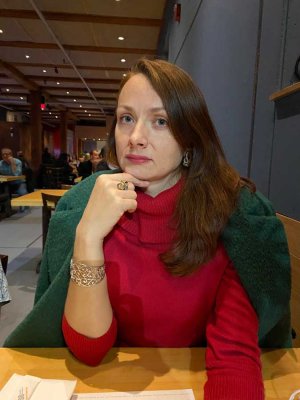
Iryna Solomko. Photo courtesy of Adrian Bonenberger.
Her parents actively shoved away their Soviet identity, made Ukrainian their family’s language, and embraced the Ukrainian traditions, such as church Easter celebrations and the Christmas Holy Eve with its 12-dish meatless feast. One of the most important included observing Aug. 24—Ukraine’s Independence Day—when national flags color the streets blue and yellow and fantastic flower compositions bedeck the landscape.
When she got older, Solomko continued her family’s tradition by fighting for Ukrainian independence and freedom as a journalist: pointing out corruption, pushing for free speech, and demonstrating to viewers what debate looks like.
But free speech ultimately depends on who owns the TV station, and she found herself leaving journalism as her ideals got shot down.
A new path arrived in the form of love: An American war veteran who brought her to New Haven, Connecticut. Soon, she had a new life, even as she struggled to regain her footing as a journalist. In Ukraine, she had been a pathbreaker, a woman whose passion caused her to defy traditional roles and lead the way forward. In Connecticut, she wondered if she would have to reinvent herself.
Just as she started to settle in—writing articles about the Ukrainian-American immigration experience—Kyiv called again. The Russians brought war, and her parents refused to flee the country they had chosen. Could Solomko, with a team of U.S. veterans, save them? And could she, as she returned to Kyiv, work against a culture that—even as it glorified history’s women combat vets—held that women should be caregivers, not fighters?
“If I had not moved to the United States, I would be in the internal forces,” Solomko tells The War Horse. “And I’m telling you, I feel so bad. Like, I’m not in Ukraine right now. I can’t even tell you how I’m suffering because of this. And I know it’s a problem.”
The trembling in her voice gives way to laughter as a Yorkie jumps into her lap during a Zoom call. “Sorry, my dog is trying to join the conversation.” Whispering in Ukrainian, she reprimands it in what sounds like an affectionate but tough tone. The dog slumps down and walks away from her desk, its paws softly pattering against the hard floor.

Iryna Solomko places flowers in front of a memorial for people killed during the Euromaidan. Photo courtesy of Adrian Bonenberger.
“When I told my parents I was even thinking about going to Ukraine to assist them, they were like, ‘You can’t do this,’” she continues. “‘Think about your son. You have obligations as a mother.’ Blah, blah, blah.”
Her parents had good reason to stay in Ukraine as their nationality came from that hard-won choice in 1991. They had always demonstrated this patriotism to their daughter: During the 2014 annexation of Crimea by Russia, which she calls “a little war,” as Solomko fundraised money for the Ukrainian army to buy specialized equipment, her mother, despite her Russian roots, called neighbors and friends for contributions. Ira called her “moscale-banderivka—a good Russian.”
“I was so proud of her in that moment,” she says.
She had to go back for them.
In so doing, she would rediscover her purpose—as a documentarian now looking at women snipers, as a journalist now working for a U.S.-government run media operation, and as a patriot fighting for her country.
‘It’s About Who You Are as a Person’
Solomko and her parents were once citizens of the Soviet Union, her mother from Soviet Russia and her father from Soviet Ukraine. When she was a child, of course, an independent Ukraine did not yet exist.
“I call myself a ‘typical Soviet Union child’ because I was born in a pretty crazy, mixed Soviet family,” Solomko says.
Her first language was Russian. “My first friend was Russian,” she says. “I went to a Russian primary school.”
She heard Ukrainian for the first time when she visited her father’s parents in their small village. “I was very patriotic, even though this wasn’t a big agenda in my family,” she says, referring to her Soviet roots. “So, like I said, this was a very typical Soviet childhood.”
Her mother comes from the historical town of Trubchevsk in the Bryansk region. There inhabitants live close to the Ukrainian border, but they consider themselves, according to Solomko, “to be at the heart of typical Russia.”
Award-Winning Journalism in Your Inbox
Solomko’s mother graduated from college with an engineering degree, and, since the Soviet Union didn’t allow people to choose where to work, she was sent to what is today western Ukraine, where Ukrainian national identity is the strongest. It was “the heart of this anti-Russian resistance,” Solomko explains. “She was communist, she was Russian. So for her, it was like double-double trouble, to be honest.”
Her mother was warned not to travel through mountains and forests while there because of the dangers posed by the Ukrainian resistance, but she didn’t feel threatened. “I believe she’s a very good person,” Solomko says, explaining that this kept her mother safe. “She’s very kind. And of course, she is a beautiful woman, and, at that moment, she was really beautiful as a young woman.”
Her mother eventually moved to the Kyiv region, but kept her friends who lived near the Russian border.
“They still call each other, and this shows that it’s not a question of, ‘Are you Russian? Are you Ukrainian?’ but it’s about who you are as a person,” Solomko says.
Her father, a retired colonel in the Security Service of Ukraine, is from a village, Slout, in northeastern Ukraine—about 75 miles from Trubchevsk, her mother’s hometown. Despite the different ethnicities marked on their old Soviet passports, the two share a common history, which Solomko says shows “all these borders and lines are pretty subjective.”
Her father served in the KGB for the Soviet Union. “Everyone makes fun of me,” Solomko says, laughing, but adds, “I believe he was a good guy. He was very respected in our community. And this is, again, about not where you are from, who you are amongst, but who you are as a person.”
Solomko’s parents met in Kyiv and settled in the suburbs after they married.
In the 1980s, they realized Soviet politics were shifting and the idea of an independent Ukraine appeared on the horizon, she says. Though her mother was Russian, they wanted to be Ukrainians. In 1991, just before Ukraine gained its independence, Solomko completed Russian primary school, and her parents switched her to the Ukrainian system for secondary school.
She started learning Ukrainian and, along with her parents and brother, decided to make it the family’s language. They are bilingual, but speaking Ukrainian for Solomko was “a political choice.”
Solomko doesn’t self-identify as Ukrainian just because she was born near Kyiv, but because she “fell in love” with the “brilliant Ukrainian language, history, and culture” in secondary school and beyond.
“I’m praying for Ukraine right now because this is my culture,” she says. “This is my nation, and I am also so proud to be Ukrainian.”
‘Journalists Are Necessary For Developing a Democracy’
The fledgling nation faced growing pains as it moved from communism to democracy: Citizens didn’t know the basics.
This is why she decided to become a journalist. “It’s an extremely important profession,” Solomoko says. “Journalists are necessary for developing a democracy.”
Her father didn’t approve of her choice, but not because of any Soviet-era misgivings. Instead, he didn’t see it as “a female profession,” he told her, insisting she “would always be on duty and never have a normal family.”
“I remember being in my kitchen and begging him, and he wouldn’t let me,” she says. He refused until her mother spoke up for her.
When Solomko finished journalism school, she joined Korrespondent magazine, one of the first to be published independently from the influence of Ukrainian political or economic interests, which was not the case for most Ukrainian media in the post-Communist era.
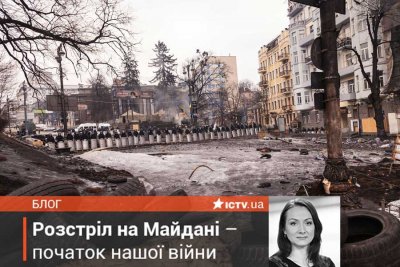
Iryna Solomko covered Euromaidan for her blog at ICTV. Photo courtesy of Iryna Solomko.
“There wasn’t any censorship,” Solomko says. “I was really proud to be part of that team. It was really crucial for Ukrainian media that the magazine existed.”
But in 2011, Ukrainian oligarch and future president Petro Poroshenko bought the magazine. Ira calls him “our bad president who tried to destroy independent media.”
She left the publication. Ira’s next job was with ICTV, Ukraine’s fourth largest TV channel. She stayed with the station while she made her first documentary, Revolution of Dignity, about the 2013-2014 Euromaidan, when then-President Viktor Yanukovych bowed to Russian pressure and didn’t sign an agreement to join the European Union. That led to mass protests and rioting across the country, which government forces violently suppressed. More than 100 people died and approximately 2,500 were injured.
After Euromaidan, “freedom of speech in Ukraine was not super good,” Solomko says, so she left ICTV based on her “integrity and principles.”
‘I’m Good With My Integrity And My Profession’
Around the time she was about to leave ICTV, Solomko met Adrian Bonenberger, who served in the U.S. army as an infantry officer from 2005 to 2012. He completed two deployments in Afghanistan and wrote two books based on his experience as a soldier: Afghan Post and The Disappointed Soldier and Other Stories From War.
In Ukraine, Bonenberger served as an unofficial member of the Truman National Security Project’s Defense Council, and he worked on a project for the Center for Civilians in Conflict on harm to civilians in the first Russo-Ukrainian war. Bonenberger met Solomko on the set of Hromadske Radio, where he spoke about the 2016 election.
Solomko says Bonenberger helped her to finally vacate her job at ICTV: “He said, ‘I understand you. You should leave this TV channel. Don’t worry.’ And I switched to this communication stuff,” she says, laughing. “But then, of course, it was over, because he brought me here to America.”
The two married near Kyiv in 2016.
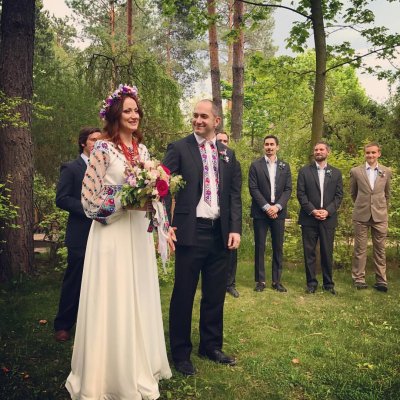
Iryna Solomko marries Adrian Bonenberger outside Kieve in 2016. Photo courtesy of Iryna Solomko.
Since 2017, she’s been in a quiet Connecticut suburb with her now-husband and her son, a Ukrainian, who will start college next year. But the transition has, once again, been difficult as she learns a new way of life.
“I had a lot of doubts about what I needed to do,” she tells The War Horse. She considered studying forestry to learn more about the effects of climate change. But she realized she still felt strongly about her career. “I can’t reinvent myself totally, and I’m a pretty good journalist, so I need to focus on my profession: a journalist.”
In 2019, she started working for a U.S. broadcasting network that provides news to audiences around the world, including countries whose leadership censors or provides misleading news. The station broadcasts in many languages besides English, including Ukrainian. Its website claims it is under a strict firewall that prevents interference by any U.S. government official or agency, thus guaranteeing journalists freedom to develop their stories.
“Here, there is no censorship,” Solomko says. “And I’m good with my integrity and with my principles and profession.”
She has been tasked with telling stories of Ukrainian immigration in America—a story she knows well since it is now her own.
“All my friends say, ‘You’re so lucky—you’re in America,’ but no one really understands how hard it is to start over,” she says. “This is why I believe that telling the stories of these Ukrainian people in America is really great. And it’s really inspiring me.”
In early February, before the invasion, Ira interviewed Jeffrey Prescott, deputy to the U.S. representative to the United Nations, about the 100,000 Russian troops amassed at the Ukrainian border.
She felt a strong need to return home, but risking her life to join the territorial defense forces in Ukraine wasn’t an option. “I have my responsibility as a mother,” she says. “My son is graduating from high school and he needs my support going to college.”
‘OK. So We Are Going There.’
But as Solomko covered the war in Ukraine from the United States, her parents refused to leave as the Russians advanced through Kyiv—even after Solomko and Bonenberger tried to convince them to come to Connecticut.
“They were not in a safe neighborhood, and they’re on the 14th floor—the top floor,” Solomko says. “And my mom has high blood pressure and some other health issues, as well. I said to them, ‘Can you imagine? You won’t have any water, you won’t have any electricity. You won’t be able to use the elevator.’”
Like many living in Kyiv who have lived with Russians threats for years, her parents never thought war would come to the capital. At Christmas, residents shopped in holiday markets and ice skated instead of preparing bomb shelters.
“But they were sure that whatever happened would localize in the east. Nobody would believe that they will try to take Kyiv. So, it’s the most unbelievable thing that could happen. And this is why they actually stayed in the apartment for a couple days at the beginning.”
They even considered joining a territorial defense force. “I was thinking until the last minute, ‘I should stay and help,” her father Dmytro Solomko told Newsy’s Sasha Ingber. “If only I were healthier and younger to protect Kyiv.”
But when the elevator broke in their building, they fled to a safer suburb to stay with one of Solomko’s friends. Still, they resisted their daughter’s insistence that they leave the country.
That’s when Solomko decided to go.
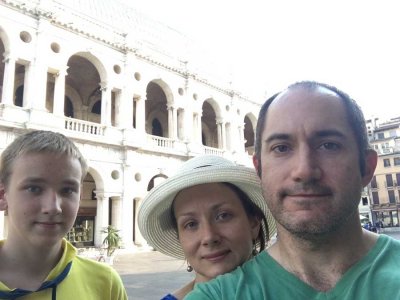
Iryna Solomko and Adrian Bonenberger sightsee with their son (left). Photo courtesy of Adrian Bonenberger.
“I kept thinking I have my responsibility as a mother because our son is graduating from high school and going to college,” she says. “I was thinking about housing for him, and this last year was really hard for him, emotional. I didn’t want this additional stress on him, but when the war began—I don’t remember what was the moment when I decided—I said, ‘Adrian, OK, so we are going there.’”
But they couldn’t just go to Ukraine, get her parents, and leave, Solomko says. They had to help, and they had to have a logistical plan. “I told Adrian we also had to have a mission there, but we had to be very specific about it.”
By specific, she meant launching a double mission at breakneck speed: getting her parents quickly out of the country and simultaneously using that time to do whatever she could to help her people.
She coordinated with a church to deliver medical supplies, food, and clothes to people as they fled. She also introduced Bonenberger to a man in Lviv who needed help with training as he built up territorial defense and organized the resistance to the Russian invasion. Lviv, a city in western Ukraine, is about 40 miles from the Polish border and had, at the beginning of March, remained largely unscathed by Russian attacks.
Two of Bonenberger’s veteran friends volunteered with him, each paying his own way: actor and writer Benjamin Busch served 16 years as an infantry and light armored reconnaissance officer in the U.S. Marine Corps, deploying to Iraq in 2003 and 2005. And novelist and short story writer Matt Gallagher served as a captain in the Army and as a cavalry officer with the 27th Infantry Regiment in Iraq.
For two weeks, they taught basic urban-combat tactics and survivability to a city defense force of about 50 local volunteers near Lviv.
‘Her Phone Was Always Ringing’
The team focused on bringing Solomko’s parents to safety. But after they arrived in Lviv, there wasn’t much she could do besides wait—in agony—as she kept track of them by phone. Air raid sirens wailed day and night. Her brother worked to evacuate her parents from Kyiv by car, a trip that, in peacetime, would have taken seven to eight hours. Due to the mass evacuation toward the west and the danger of getting caught in the fighting, the trip took three days, and they were forced to sleep in an abandoned school dormitory.
Her parents’ perilous journey wasn’t the only plan that took longer than envisioned: The aid pallets she helped bring went missing for the first nine days of their time in Ukraine.
Despite the delays, Solomko continued her efforts to help.
“When we were there, her phone was always ringing—she was always offering her services,” Gallagher says. “Nothing would have been possible without her—transportation, lodging—she introduced us to the city of Lviv, handled all the relief work. She engaged some of her former colleagues to help, too. I don’t think she slept the entire time she was there.”
He called her “quietly heroic.”
“We’d see her when we returned, and she would still be on the phone or computer locating a vanishing and reappearing tractor trailer of aid supplies from the U.S. that she had arranged the collection of and international transportation for,” Busch says.
Before Solomko’s parents arrived, the Russians bombed an aircraft repair facility. Lviv had lost its status as battle-free haven.
“This moment when I was able to hold my mom, see my dad,” Solomko says, “was one of the most important moments, probably of all my life.”
But being back in Ukraine once again forced Solomko to reassess her passions.
‘Everything Happened Because of Her’
The harrowing images of women fleeing Russia’s war with Ukraine with their children under deplorable conditions—to perhaps never see husbands or fathers again—have convinced governments, organizations, and individuals worldwide to contribute to a record-breaking humanitarian outreach campaign. Less visible have been the women who left their professions and families to join the domestic fight against the invaders, a tradition that dates back more than a century.
“They stay,” Solomko says about women fighting the Russians. “They’re like, ‘I’m taking a rifle and I’m going to protect my country.’ So it’s really become a trend in Ukraine that nobody cares if you are a woman or if you are a man. If your country needs you, you just go and protect it, and there’s no coming back to this female or male idea.”
Female Ukrainian officers have served in World War I, in the Austro-Hungarian army, and in the Red Army during World War II. Today, women make up 15% to 17% of the armed forces in Ukraine. Lyudmila Pavlichenko, the WWII sniper famously labeled “Lady Death” after 309 confirmed kills for the Soviets, was a native of Kyiv.

Lyudmila Pavlichenko with First Lady Eleanor Roosevelt and Associate Justice Robert Jackson upon her arrival to Washington, D.C. Photo courtesy of the Library of Congress.
“The Russians want to say she’s Russian,” Solomko says. “There was a movie made about her. And actually, even the Russians tried to use her image. But her last name is Ukrainian. She’s Ukrainian.”
Pavlichenko, long after touring the United States with Eleanor Roosevelt to encourage the country to enter World War II, was often cited as an example of why American women could serve in combat positions.
Solomko’s group still encountered gender bias in Ukraine.
“I’d say, as a generalization about women in Ukraine, is that it’s a paternalistic society in which women rarely have the same opportunities as men,” Bonenberger tells The War Horse.
But that generalization belies the history of the region.
“There’s a long legacy of women fighting in wars, that goes back before WWII, and they’re always welcomed behind the scope of a rifle pointing at Russian invaders,” he says.
At first, the Ukrainian volunteers didn’t plan to include women in the training group with the American veterans to defend their country. But the women could have evacuated, and instead chose to stay, so Busch insisted the training include women, Gallagher says—because even as Ukrainian women mix molotov cocktails to battle the Russians, social mores about women in warzones remained.
“I would ask the women what they believe the particular challenges they face are, but it’s likely just convention, tradition, and perception,” Busch says. “Strength has long been associated with war, but everyone can pull a trigger. We aren’t fighting with battle axes anymore.”
It took “some of the men a bit to get used to having women there in those roles, but they got used to it quickly,” Gallagher says. “Some of the women were excellent shots.”
Gallagher recalls his first experience with women in combat roles in Iraq: “I remember when I was in the Army, women weren’t yet allowed in combat positions but, of course, were still seeing and experiencing combat in support roles. On the practical level, the terminology didn’t make much of a difference.”
In Ukraine, even the women who serve from the rear aren’t much safer than those on the front lines, with the civilian casualties at more than 4,500 in mid-June, according to the United Nations High Commissioner for Human Rights. And their roles are just as important.
Solomko and other women are essential for leading the resistance behind the front lines because, she says, “the primary role of organization and also humanitarian aid is on women’s shoulders.” While many Ukrainian women fight at the front, the soldiers are mostly male, which translates to a lack of men to help out.
“And there’s a more interesting thing,” Solomko says: “Even to bring humanitarian aid from Poland to Ukraine, it’s mostly women who do it because it is illegal for men to cross the border. So women are driving these trucks back and forth to bring this humanitarian aid to Ukraine.”
Adam Tsou, Bonenberger’s college friend, helped run humanitarian aid logistics for the team.
“Iryna was most certainly the boss,” he says.
Solomko didn’t give many more details or anecdotes about her specific role in the Ukraine mission, even when asked. She spoke always of the group or the Ukrainian people. Referring to the women helping, but also referring to herself, she said, “We try to help as much as possible, to stand and to be strong.”
Solomko didn’t fire a weapon or train anyone to kill Russians. Still, she saved lives.
“Everything we did and accomplished happened because of her,” Gallagher says. “She got us home safely.”
‘She Has so Much More Strength’
Solomko continues her work as a journalist, writing about Ukraine and its uprooted people.
Her parents now live in Connecticut, but her brother, due to the law forbidding adult males younger than 60 from leaving the country, remains in Ukraine.
Given her community-minded approach to the war, it shouldn’t come as a surprise that it was Gallagher and Bonenberger, not Solomko, who told The War Horse Solomko, while in Lviv, was offered the prestigious job of press secretary for the International Legion of Defence of Ukraine, created by President Volodymyr Zelensky in February 2022 to recruit foreign volunteer battalions.
Would she have been able to secure her dream of reporting without censure about the most important event in modern Ukrainian history from Ukraine? Impossible to know: She turned the offer down.
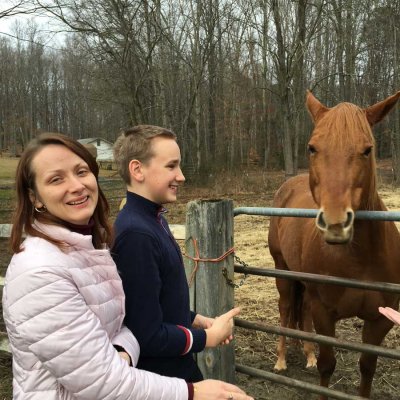
Iryna Solomko visits a horse with her son. Photo courtesy of Adrian Bonenberger.
But she spoke at length about the documentary she’s making about female snipers. Solomko has made at least nine documentaries for Ukrainian TV detailing the human aspects of the military and the country’s other armed struggles, including one called Volunteers about volunteer paratroopers with the Armed Forces of Ukraine, who substantially contributed to the ATO, an anti-terrorist operation launched in eastern Ukraine against Russian separatists in February 2018.
She met several women snipers while filming documentaries in Ukraine in 2014. At the time, the Ukrainian government hadn’t passed the law allowing women to serve in official combat roles. They could only be assigned as cooks or nurses. However, because so many women volunteered in 2014 to help expand Ukraine’s military, women were legally granted combat positions in 2016.
While this was a “very significant breakthrough,” to Solomko, female snipers remain in a special category in Ukraine because, since they have always been unofficial, their commitment and determination is “100%,” as is their “maturity, skill, level of physical fitness—the same for males—and readiness to do whatever you can to protect your country.”
Our Journalism Depends on Your Support
One could say the same of Solomko, who, as someone who fought for freedom of speech in Ukraine and then married into the U.S. veteran community, has used her vantage point as a new American to continue to protect her home country.
“I have an incredible amount of respect for Iryna as a person, but then also really seeing her in action for this specific project and life situation that occurred,” Tsou says. “She has so much more strength than I could probably pull together, so I am very humbled by seeing her in action.”
This War Horse feature was reported by Jennifer Orth-Veillon, edited by Kelly Kennedy, fact-checked by Ben Kalin, and copy-edited by Mitchell Hansen-Dewar. Abbie Bennett wrote the headlines.





Comments are closed.